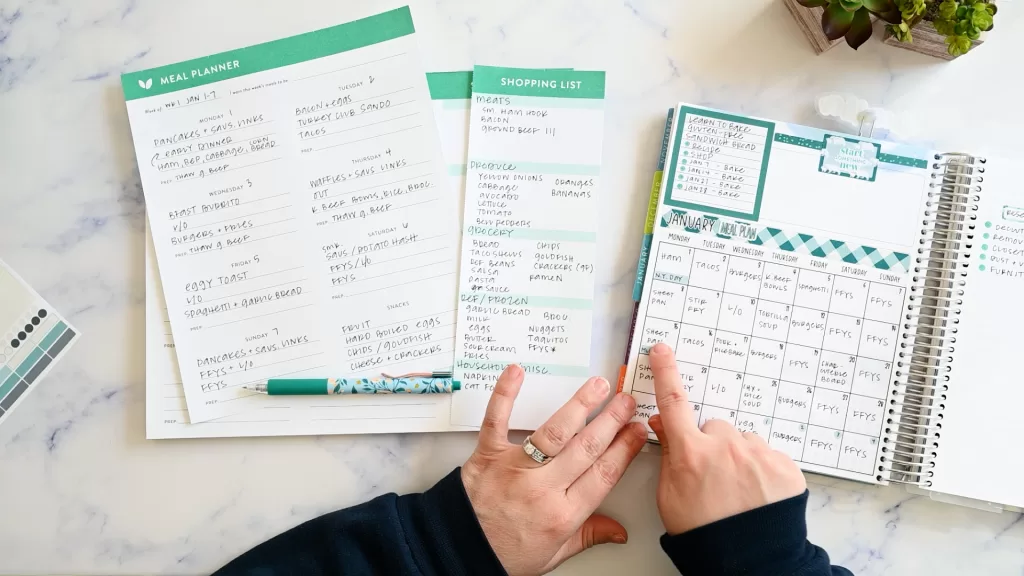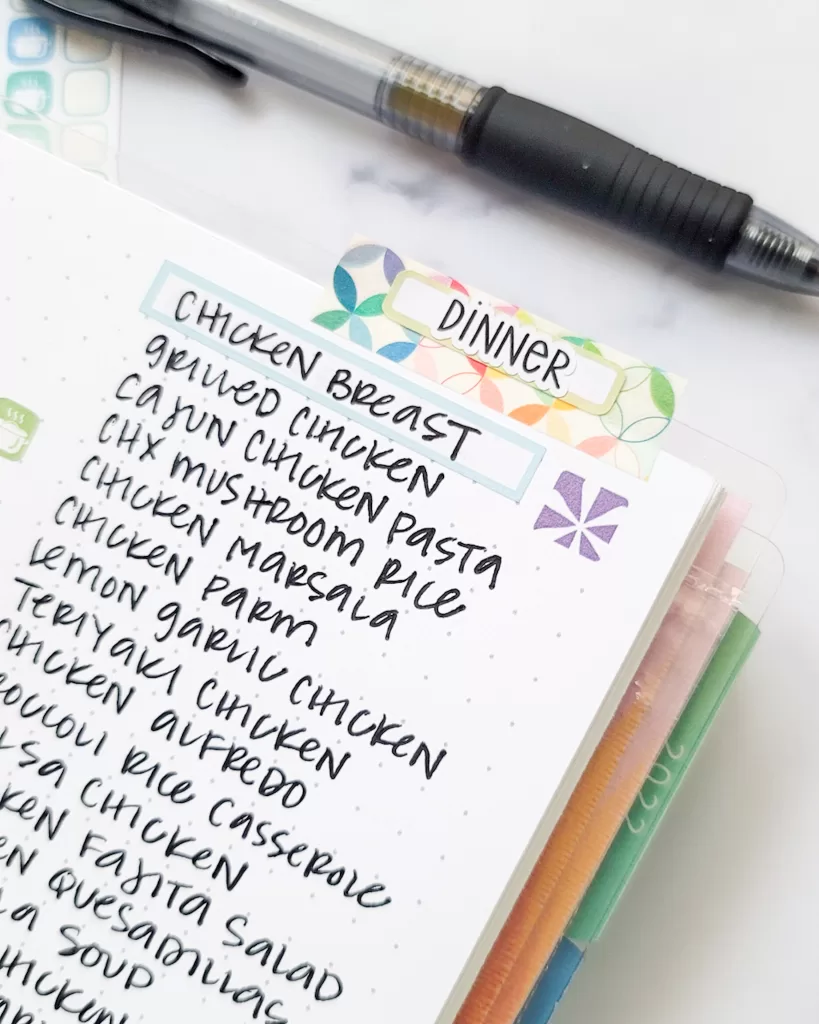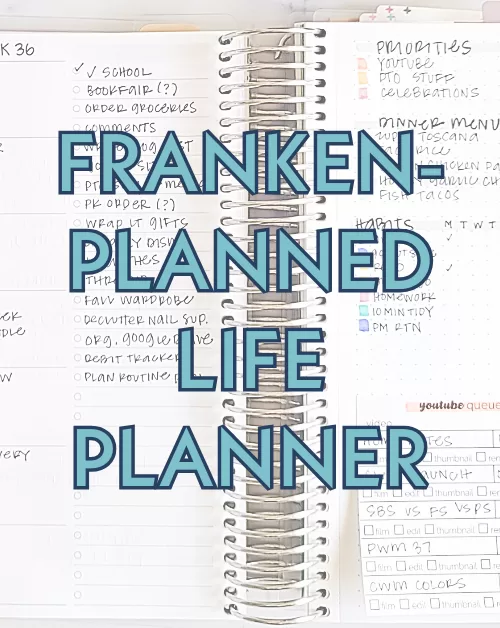Are you tired of the weekly stress of meal planning? Do you find yourself staring blankly at the fridge, wondering what to cook for dinner? If so, you’re not alone. Many people struggle with meal planning, but with a little organization and a simple monthly menu planning system, you can take the stress out of mealtime.

The links on this page may be affiliate links. If you make a purchase after clicking, I will receive a small percentage (it costs you nothing). Visit my favorites page for coupon codes!
Why Should You Consider Monthly Menu Planning?
Monthly menu planning helps to reduce the mental load associated with feeding your family. There is a lot involved with meal planning including:
- family member food preferences
- family member dietary restrictions
- schedules
- grocery shopping
- budget planning
- finding time to cook
- keeping up with food inventory
- managing leftovers
- trying recipes
- …and so much more!
Monthly menu planning consolidates many of these considerations into a single session. It frees up brain space each week to devote to other things. When it’s time to shop for groceries, the menu has already been planned. You can scan your list and match ingredients with what you already have on hand and quickly get your groceries figured out.
While digital tools can be helpful, there’s something satisfying about planning your meals in a physical planner. It allows you to visualize your month and track your progress. By planning your meals for the entire month, you can:
- Save time: No more scrambling to figure out what to cook each night.
- Save money: Reduce food waste by only buying what you need.
- Eat healthier: Plan meals that are balanced and nutritious.
- Reduce stress: Take the guesswork out of mealtime.
Monthly Menu Planning Best Practices
How to plan your dinner menu for the whole month:
- Pick a day each month to plan the dinner menu for the following month (preferably after you’ve planned the schedule)
- Scan your planner and your family’s schedule to keep any important dates in mind (celebrations, evening activities)
- Use a menu matrix to easily plug in your family’s favorite meals (Meatless Monday, Taco Tuesday)
- Before each week begins, review the menu for any last-minute changes in the schedule and adjust as needed.
- Prep your grocery list.
- Order your groceries for pickup or delivery. I love using Walmart+ with the In-Home add on.

How to Create a Monthly Meal Plan in Your Paper Planner
- Choose a Planner:
- Monthly View: Look for a planner with a monthly overview, allowing you to see the entire month at a glance.
- Weekly View: A weekly view can be helpful for detailed meal planning and grocery lists.
- Dedicated Meal Planning Pages: Some planners have specific pages for meal planning, which can be very convenient. Try the Plum Paper meal planning add-on! (Using my link serves as a Plum Paper coupon code to save you 10%).
- Helpful Planner Stickers: I really like the large format stickers from PlannerKate to add extra function to blank or unused planner pages. (Use my PlannerKate coupon code KK20 to save an additional 20%).
- Identify Your Go-To Meals:
- Quick and Easy Dinners: These are meals that you can whip up in no time, like pasta, stir-fries, or grilled cheese. See my list of 60 Easy Dinner Ideas.
- Crockpot Meals: Slow cooker meals are perfect for busy weeknights. Make sure to note these in your planner so you remember to start them in the morning!
- Leftover Makeovers: Repurpose leftovers into new meals, such as soups, casseroles, or sandwiches.
- Consider Your Schedule:
- Busy Weeks: Plan simple meals that require minimal prep and cooking time.
- Relaxed Weekends: Schedule more time-consuming meals, like roasting a chicken or making homemade pizza.
- Create a Flexible Menu:
- Build-Your-Own Meals: Create a list of protein, vegetable, and grain options.
- Theme Nights: Dedicate specific nights to certain cuisines, like Italian or Mexican.
- Leftover Nights: Plan a night to use up leftovers.
Using Your Planner Effectively for Monthly Menu Planning
- Color Coding: Use different colors to categorize meals, such as red for meat, green for vegetarian, and blue for seafood.
- Stickers and Highlighters: Use these to highlight special occasions, holidays, or important events.
- Grocery List Section: Dedicate a section of your planner to a grocery list. As you plan your meals, add ingredients to the list.
- Meal Prep Ideas: Use a separate page to jot down meal prep ideas, such as marinating meats or chopping vegetables. Check out my suggestions for meal prep and menu planning products on Amazon.
Adapting to Changes
Life is unpredictable, and your monthly menu plan may need to be adjusted. Here are some tips for staying flexible:
- Be Prepared to Pivot: If your schedule changes, be ready to switch up your meal plan.
- Cook Ahead: Prepare meals in advance and freeze them for later. I’m trying out some silicone freezer molds for this. I’ll let you know how I like them soon!
- Embrace Spontaneity: Sometimes, it’s okay to order takeout or eat out.
Monthly Menu Planning + Grocery Routine Video
By following these tips and creating a personalized monthly menu planning system in your paper planner, you can take control of your meals and simplify your life. Remember, the goal is to make mealtime enjoyable and stress-free.
Free Monthly Menu Planning Guide and Workbook
Don’t forget to download my free monthly menu planning guide and workbook! This easy menu planning guide is versatile and can work with any dietary preferences. You will learn strategies on how to plan a menu instead of just getting a list of meals to make.
Simply sign up for my free newsletter to get member’s only access to your FREE menu planning guide + workbook along with other helpful resources (like printable sticky notes). More freebies are being added all the time!
Functional Planning Free Printables
Join my newsletter to stay connected. You’ll get:
- access to my free printables library
- updates about new content on the blog
- heads up about sales and product launches
- links to new videos you may have missed




[…] not all of my habits were detrimental to my progress. I learned that my habit of planning my family’s dinners on a monthly basis had a positive impact. The habit meant I didn’t have to spend mental energy every week […]
[…] Read More: Menu Planning Basics […]
[…] my monthly menu planning process to save money on your grocery budget and reduce the mental load that comes with feeding your […]